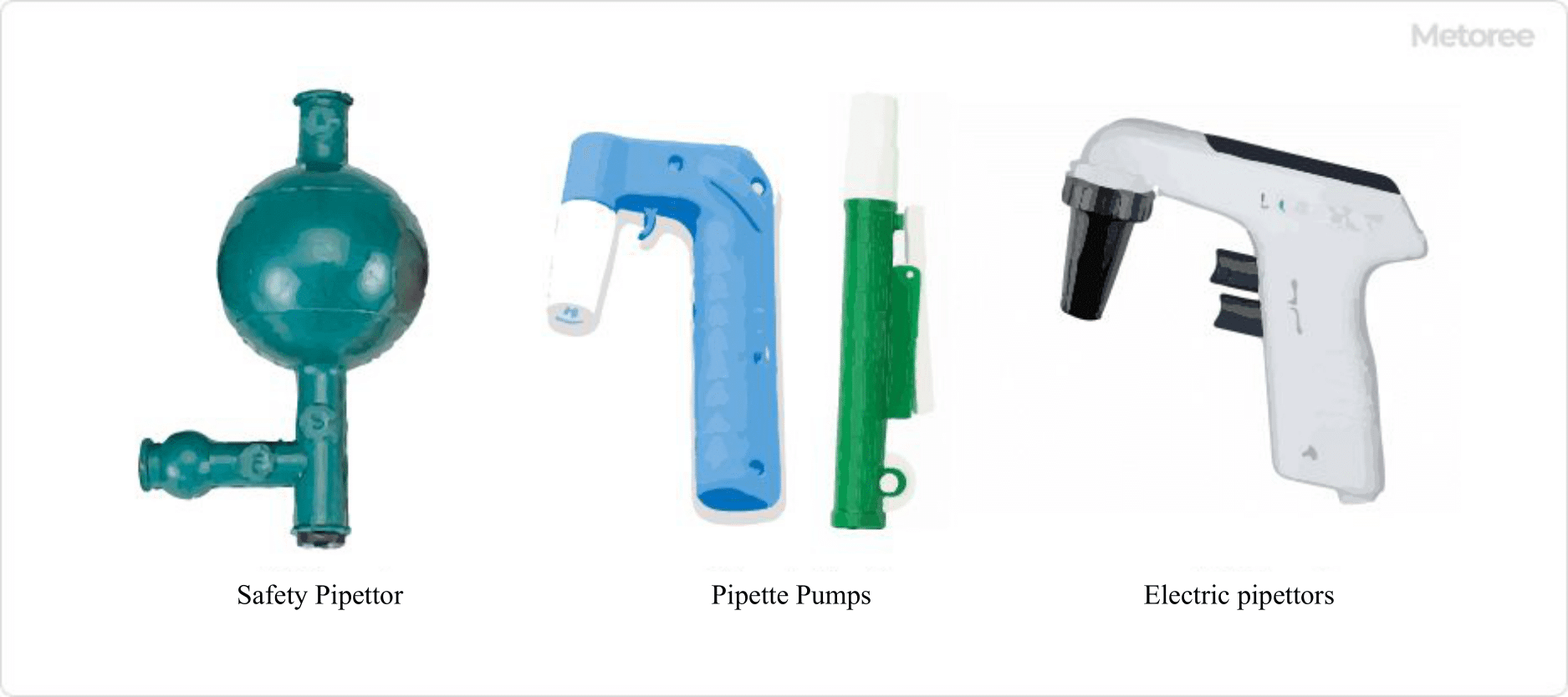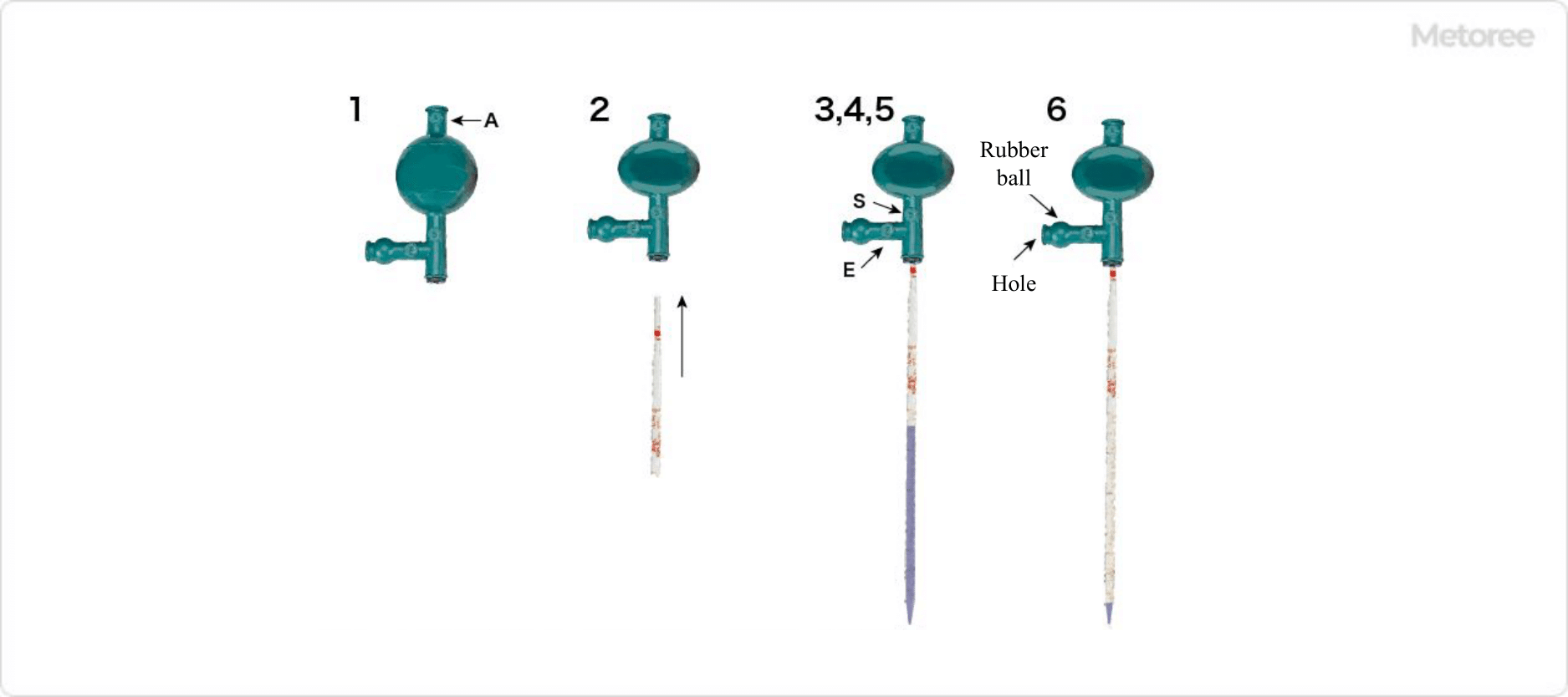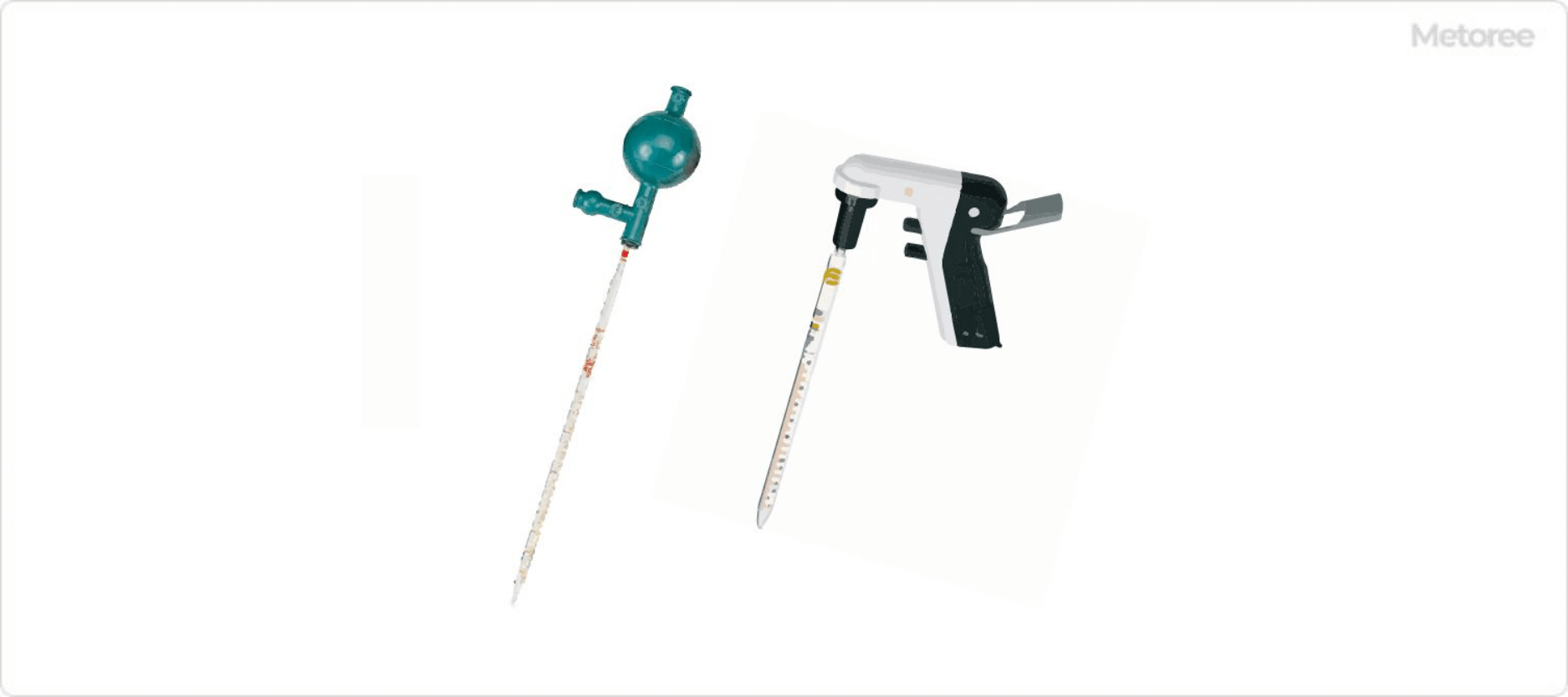All Categories
History








This section provides an overview for pipettors as well as their applications and principles. Also, please take a look at the list of 8 pipettor manufacturers and their company rankings. Here are the top-ranked pipettor companies as of July, 2025: 1.Scilogex, LLC, 2.BrandTech Scientific, Inc., 3.Dynalab Corp..
Table of Contents

Figure 1. Various pipettors
A pipettor is an instrument that is attached to a pipette, such as a whole pipette or a female pipette, and performs the pipetting action of sucking up and dispensing solution.
Alternatively, it may refer to a pipette that has its own aspirating function. Pipettors include manual safety pipettors, pipette pumps, and electronic pipettors.
Recently, electronic pipettors are the most common; they can set the pipette volume with a dial on the hand, aspirate with a single push of a button, and dispense with a single push of a button.
Pipettors are used throughout the chemical and biological fields for all pipetting operations in which a fixed amount of liquid is aspirated to measure or dispense into another container.
Examples of liquids used include solvents, solutions, samples, media, additives, etc. Micropipettors are also commonly used for the injection of minute amounts of liquids of 1 mL or less.
Hole pipettes and scalpel pipettes were used in the past to suck up solutions by mouth. However, since it is dangerous to aspirate chemicals, especially hazardous substances, by mouth using pipettes or female pipettes, Pipettors are now commonly used as an alternative.
Manual and automatic pipettors are used for aspirating and dispensing a certain amount of organic substances, etc., because only the tip of the pipette is wetted and the tip can be removed without being touched.

Figure 2. Using the Safety Pipetter
One type of pipettor, the safety pipettor, is a manual type that is attached to a female pipette or similar instrument. The air intake valve is pressed to depress the rubber ball, the liquid intake valve is pressed to suck up the liquid, and the discharge valve is pressed to drain the liquid.
Instructions for use are as follows:
Pipette pumps are constructed with a piston that moves air in and out by moving the piston up and down. The distance it moves up and down can be finely adjusted with a dial, and the amount of air that is moved in and out can be finely adjusted, making it possible to precisely and accurately adjust the amount of liquid.
Electronic pipettors use a motor to perform a series of operations that are labor-saving and can be done at the touch of a button. Most products on the market today are powered by rechargeable batteries. However, recharging time and whether the product can be used while recharging vary from product to product.
While a regular pipette needs to be cleaned and dried each time a chemical is changed, manual and motorized pipettors allow for the immediate injection of a different liquid by simply replacing the pipette tip that is wetted. The pipettes are designed to be removed without touching the tip, eliminating the risk of hazardous substances adhering to the body and improving not only workability, but also safety.

Figure 3. Pipettor with pipette attached
Since each pipettor has its own characteristics, it is important to select the appropriate one for your experimental use and purpose.
First, identify the volume of liquid to be handled in one pipetting run in the experimental system you wish to use: a micropipette may be appropriate for small-scale experiments involving less than 1 mL, while a graduated pipette is appropriate for those involving more than 100 mL. A safety pipettor, pipette pump, or motorized pipettor is then preferred.
Most electric pipettors can handle female pipettes with a lower limit of 0.5mL or 1mL and an upper limit of 100mL. Pipette pumps are available for 2mL, 10mL, and 25mL. Also note that charging time, usability during charging, and aspiration/dispensing speeds vary from product to product.
In order to obtain accurate experimental data, products should be considered from the perspective of contamination prevention when selecting a product. It is desirable to select a product with a cap and filter that are designed for easy cleaning. In addition, it is recommended that caps and filters be autoclavable for biological experiments.
*Including some distributors, etc.
Sort by Features
Sort by Area

Globe Scientific Inc. is an American ISO 9001 certified manufacturer of laboratory equipment that was founded in 1983 before its acquisition by the GSI group in 2022. Headquartered in Mahwah, New Jersey, the company produces laboratory benchtop equipment, glassware, and plasticware including centrifuges, vials, microscopes and beakers. These are primarily used for chemical testing or analysis, research, and quality control applications. Globe Scientific also offers contract manufacturing and packaging services for customer projects and equipment orders. The company chiefly serves clients in the education, healthcare, biotechnology, and laboratory sectors.

Dynalab Corp was founded in Rochester, New York in 1957. Together with its wholesale division, Dynalon Labware, Dynalab produces and distributes standard and custom-made scientific equipment and laboratory supplies across North America. Science equipment and sampling apparatus offerings include hygrometers, mailing point devices, rollers, water stills, powders, seals, various samplers, and drills. Some of Dynalab’s laboratory supplies include Azlon plastics, burn-up boxes, desiccators, hydrometers, pipettes, shields, stopcocks, tote boxes, tubing, and watch glasses.

Thermo Fisher Scientific Inc., founded in 1956 and headquartered in Waltham, Massachusetts, is a manufacturer and supplier of life science solutions, analytical instruments, specialty diagnostics, laboratory products, and biopharma services. Through its brand names, including Invitrogen, Fisher Scientific, Patheon, Applied Biosystems, and Gibco, among others, the company provides a wide range of products, which include chromatography systems, thermal cyclers, automated cell counters, fermenters, and DNA polymerases. The company’s annual revenue is over 40 billion USD, and it serves several fields, including customers working in clinical diagnostic labs, research institutions, hospitals, government agencies, and pharmaceutical/biotech companies.

SCILOGEX Liquid Handling Products and Bench-top Instruments are available through our authorized distributor network. To locate a distributor in your area please contact us. Our knowledgeable staff will be delighted to provide you with pre-purchase support and product recommendations.Our Liquid Handling Products come with a 1 year warranty and our Bench-top Instruments come with a 2 year warranty and are manufactured in an ISO9001 facility and cTUVus certified for UL & CSA so you can purchase in confidence. Please visit our New Products page frequently to keep up to date with new and exciting products and our Promotions page for the latest great deals we are offer.We thank you for your continued support and we look forward to bringing you new and exciting products at VERY competitive prices.

BrandTech Scientific was founded in 1996 and is headquartered in Essex, Connecticut. BrandTech Scientific supports laboratory sciences as a distributor for German-made supplies in Canada and the United States. BrandTech Scientific’s products include categories such as liquid handling including pipettes and instrumentation, life science such as PCR products and microplates, laboratory vacuum such as rotary vein pumps, lab support jacks, lab ware such as test tube racks, volumetric lab ware hardware and software, and lab rat gear, as well as offering vacuum pump selection guides.

CLIAwaived, Inc. was founded in 2003 and is based in Carlsbad, California. The company is a distributor of medical and laboratory-related equipment for individual and medical provider customers. The company’s primary product lines include testing supplies, women’s health, and other medical products & supplies. Among the types of testing supplies equipment are COVID-19 testing supplies, blood alcohol testing kits, drug testing tools, and health condition testing elements. Most orders placed before 8 PM Easter Time ship within 1 business day.



Mettler Toledo was incorporated in 1945 in Toledo, Ohio, and is today headquartered in Greifensee, Switzerland. Mettler Toledo is a manufacturer of various analytical instruments for use in laboratories, industrial and manufacturing, and food retailing applications to customers globally. Mettler Toledo offers many products across product lines for uses such as product inspection, process analytics, jewelry scales, moisture analyzers, and software for laboratory weighing. Mettler Toledo also offers numerous accessories such as density kits, hands-free accessories, weighing tables, and weight accessories.
Ranking as of July 2025
Derivation Method| Rank | Company | Click Share |
|---|---|---|
| 1 | Scilogex, LLC |
20.0%
|
| 2 | BrandTech Scientific, Inc. |
20.0%
|
| 3 | Dynalab Corp. |
20.0%
|
| 4 | Mettler-Toledo |
13.3%
|
| 5 | Globe Scientific Inc. |
6.7%
|
| 6 | CLIAwaived,Inc |
6.7%
|
| 7 | Thermo Fisher Scientific Inc. |
6.7%
|
| 8 | Icams Lab Co., Ltd. |
6.7%
|
Derivation Method
The ranking is calculated based on the click share within the pipettor page as of July 2025. Click share is defined as the total number of clicks for all companies during the period divided by the number of clicks for each company.Number of Employees
Newly Established Company
Company with a History
*Including some distributors, etc.
*Including some distributors, etc.
| Country | Number of Companies | Share (%) |
|---|---|---|
 United States of America
United States of America
|
6 | 75.0% |
 Japan
Japan
|
1 | 12.5% |
 Germany
Germany
|
1 | 12.5% |
75 products found
75 products
Icams Lab Co., Ltd.
440+ people viewing
Last viewed: 21 hours ago
Currently, it is said that 95% of the dropping work performed by researchers using pipettes is done manually. Not only does the manual dripping pro...
INTEGRA Biosciences AG
590+ people viewing
Last viewed: 4 hours ago
The conventional pipette rotates one plunger over and over to set the capacity. However, this method is tired of frequent adjustments. To change it...
Icams Lab Co., Ltd.
340+ people viewing
Last viewed: 7 hours ago
A major burden on workers during dispensing work is frequently switching the dispensed amount and maintaining concentration for long periods of tim...
INTEGRA Biosciences AG
690+ people viewing
Last viewed: 23 hours ago
The intuitive ease of use such as handheldo electric pipettes enables pipetting 24, 96 and 384 channels at a time. You can select the best head fr...
2 models listed
Yagyu Shokai Co., Ltd.
210+ people viewing
Last viewed: 1 day ago
■Features It has excellent temperature characteristics (-60 to +200℃), so there is no change in quality due to temperature.
Yagyu Shokai Co., Ltd.
220+ people viewing
Last viewed: 6 hours ago
Yagyu Shokai Co., Ltd.
250+ people viewing
Last viewed: 4 hours ago
Yagyu Shokai Co., Ltd.
200+ people viewing
Last viewed: 1 day ago
■Features This is the type used for pipettes.
Icams Lab Co., Ltd.
320+ people viewing
Last viewed: 18 hours ago
A major burden on workers during dispensing work is frequently switching the dispensed amount and maintaining concentration for long periods of tim...
INTEGRA Biosciences AG
410+ people viewing
Last viewed: 20 hours ago
Serrinistic pipetting can be a repetitive and broken task, so we have prepared an innovative Pipetboy product lineup. • PipetBoy Pro and PipetBoy ...
Yagyu Shokai Co., Ltd.
230+ people viewing
Last viewed: 1 day ago
Yagyu Shokai Co., Ltd.
230+ people viewing
Last viewed: 21 hours ago
■Features The discharge type is integrally molded, allowing safe and reliable air supply.
Yagyu Shokai Co., Ltd.
300+ people viewing
Last viewed: 8 hours ago
■Features This is the type used for pipettes.
Yagyu Shokai Co., Ltd.
220+ people viewing
Last viewed: 5 hours ago
Yagyu Shokai Co., Ltd.
210+ people viewing
Last viewed: 1 day ago
Science and Health with Chemistry Co.,Ltd.
240+ people viewing
Last viewed: 1 day ago
■Product overview ・Dynamic drainage + gravity drainage ・Membrane protection ・6 levels of adjustable pipetting speed ・LCD display
A and Day Co., Ltd.
970+ people viewing
Last viewed: 2 hours ago
A&D's MPA series is ・Because it is electric, it is accurate, speedy, and fatigue-free. ・Even though it is electric, it is light, hard to break, a...
5 models listed
Icams Lab Co., Ltd.
290+ people viewing
Last viewed: 57 minutes ago
A major burden on workers during dispensing work is frequently switching the dispensed amount and maintaining concentration for long periods of tim...
G -Science
160+ people viewing
Last viewed: 1 day ago
■Product overview The MPB series is a convenient pipette that is ergonomically designed for ease of use. In addition to the standard dispensing mod...
Japan Science Core Co., Ltd.
170+ people viewing
Last viewed: 1 hour ago
■Features Powerful yet quiet pump can fill a 25mL pipette in less than 4 seconds ・Soft-grip push buttons improve ergonomics ・Autoclavable pipette...
F.C.R. & Bio Co., Ltd.
180+ people viewing
Last viewed: 7 hours ago
■Features - Can be used continuously for 20 hours with quick charge up and long-life lithium-ion battery. - Can operate with AC100 to 240 volt elec...
Kokugo Co., Ltd.
220+ people viewing
Last viewed: 1 day ago
A safety dropper for pipettes that has been consistently used.
Kokugo Co., Ltd.
250+ people viewing
Last viewed: 17 hours ago
■Features ・Thoroughly pursues ease of use while retaining the benefits of an electric type ・Position of suction/discharge button, operation feel ...